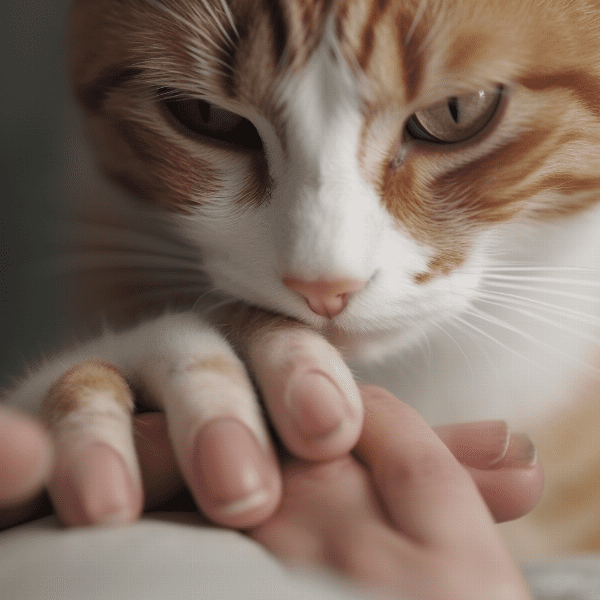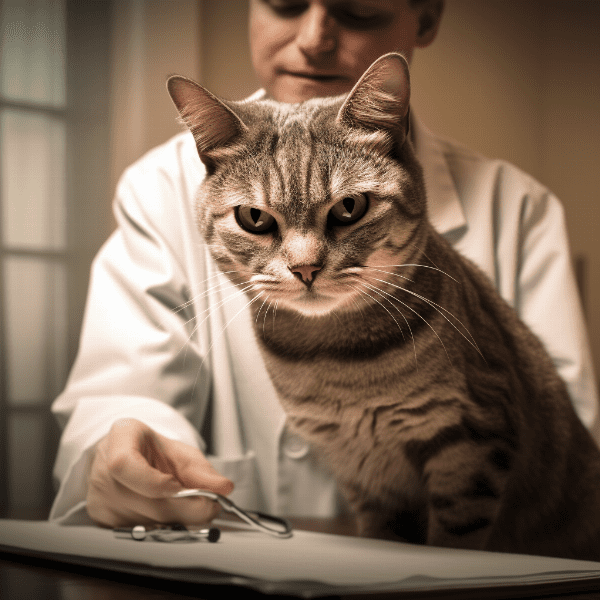Table of Contents
- Understanding Feline Toe Cancer: An Introduction
- Symptoms and Signs of Feline Toe Cancer
- Causes and Risk Factors of Feline Toe Cancer
- Diagnosis of Feline Toe Cancer
- Treatment Options for Feline Toe Cancer
- Surgery for Feline Toe Cancer: What to Expect
- Radiation Therapy for Feline Toe Cancer
- Chemotherapy for Feline Toe Cancer
- Managing Feline Toe Cancer: Prognosis and Follow-up
- Preventing Feline Toe Cancer: Tips for Cat Owners
Understanding Feline Toe Cancer: An Introduction
Feline toe cancer, also known as digital squamous cell carcinoma, is a common type of cancer that affects the toes of cats. It is a malignant tumor that arises from the skin cells on the toe and can spread to other parts of the body if left untreated.
What is Squamous Cell Carcinoma?
Squamous cell carcinoma is a type of cancer that affects the flat cells that make up the outer layer of the skin. It can occur on any part of the body, including the toes of cats. The condition is caused by the uncontrolled growth of abnormal cells that form a tumor.
Types of Feline Toe Cancer
There are several types of feline toe cancer, including squamous cell carcinoma, melanoma, and fibrosarcoma. Squamous cell carcinoma is the most common type of feline toe cancer, accounting for approximately 60% of all cases. Melanoma is a less common type of feline toe cancer that arises from the pigment-producing cells in the skin. Fibrosarcoma is a rare type of cancer that arises from the fibrous tissue in the toe.
Symptoms of Feline Toe Cancer
The symptoms of feline toe cancer can vary depending on the type and stage of the cancer. In the early stages, there may be no visible signs of the cancer. As the cancer progresses, cats may develop lameness or reluctance to bear weight on the affected toe. Other symptoms may include swelling, redness, bleeding, and discharge from the toe. In advanced stages of the disease, the cancer may spread to other parts of the body, such as the lymph nodes and lungs.
Risk Factors for Feline Toe Cancer
Several risk factors can increase the likelihood of a cat developing toe cancer. These include exposure to sunlight, certain breeds of cats (such as white or light-colored cats), age (cats over 10 years old are at higher risk), and a weakened immune system. Cat owners should be aware of these risk factors and take steps to minimize their cat’s exposure to them.
In summary, feline toe cancer is a serious condition that can affect cats of any age or breed. Understanding the causes, symptoms, and risk factors of this disease is essential for early detection and treatment. If you suspect your cat may have feline toe cancer, seek veterinary care immediately.
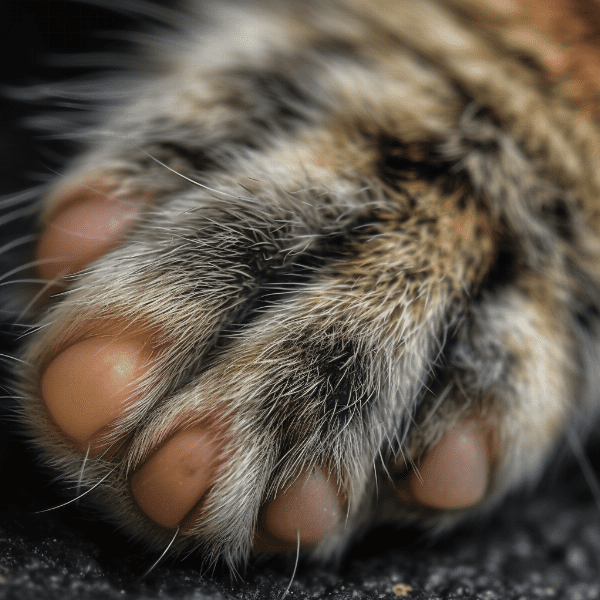
Symptoms and Signs of Feline Toe Cancer
It’s essential to know the signs and symptoms of feline toe cancer to detect it early and increase the chances of successful treatment. Here are some common symptoms to look out for:
Lameness or Reluctance to Bear Weight
Lameness or reluctance to bear weight on the affected toe is one of the most common symptoms of feline toe cancer. This symptom may develop gradually, and your cat may start to limp or avoid using the affected paw altogether.
Swelling and Inflammation
Swelling and inflammation around the affected toe are another common symptom of feline toe cancer. The swelling may be firm to the touch and may be accompanied by redness and warmth.
Ulcers or Sores
In advanced stages of the disease, feline toe cancer can cause ulcers or sores on the affected toe. These sores may bleed or ooze discharge and may have a foul odor.
Changes in Claw Appearance
Feline toe cancer can cause changes in the appearance of the affected claw. The claw may become misshapen or discolored, and the nail bed may appear red or inflamed.
Lumps or Bumps
Lumps or bumps on the toe are another symptom of feline toe cancer. These lumps may be small and firm, or they may be larger and softer to the touch.
It’s important to note that some cats may not show any visible signs of feline toe cancer until the disease has progressed to an advanced stage. That’s why it’s essential to monitor your cat’s behavior and seek veterinary care if you notice any changes in your cat’s gait, behavior, or overall health.
In summary, the signs and symptoms of feline toe cancer can vary depending on the type and stage of the cancer. If you notice any changes in your cat’s behavior or notice any of the above symptoms, seek veterinary care immediately. Early detection and treatment can significantly increase the chances of successful treatment and recovery.
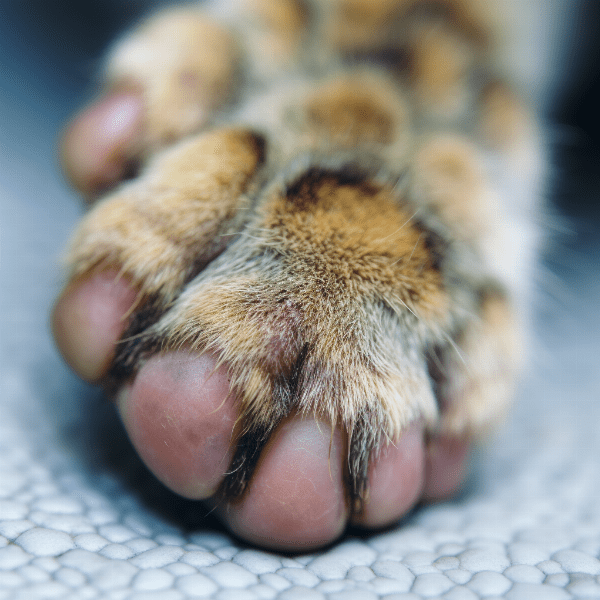
Causes and Risk Factors of Feline Toe Cancer
The exact cause of feline toe cancer is unknown, but several risk factors have been identified that may increase a cat’s likelihood of developing the disease.
Exposure to Sunlight
Exposure to sunlight is a significant risk factor for developing feline toe cancer, especially in cats with white or light-colored fur. The ultraviolet (UV) radiation from the sun can damage the DNA in the skin cells on the toe, leading to the uncontrolled growth of cancer cells.
Breed
Certain breeds of cats are more susceptible to developing feline toe cancer than others. For example, Siamese and Himalayan cats have a higher risk of developing squamous cell carcinoma.
Age
Age is another risk factor for feline toe cancer. Cats over the age of 10 are more likely to develop the disease than younger cats.
Weakened Immune System
A weakened immune system can increase a cat’s risk of developing feline toe cancer. Cats with feline immunodeficiency virus (FIV) or feline leukemia virus (FeLV) are more susceptible to developing the disease.
Genetics
Genetics may play a role in the development of feline toe cancer. Some cats may have a genetic predisposition to developing the disease.
It’s important to note that not all cats with the above risk factors will develop feline toe cancer. However, cat owners can take steps to reduce their cat’s risk of developing the disease. These steps include limiting their cat’s exposure to sunlight, feeding a healthy diet, and keeping their cat’s immune system strong.
In summary, the exact cause of feline toe cancer is unknown, but several risk factors have been identified. Understanding these risk factors can help cat owners take steps to minimize their cat’s risk of developing the disease. If you’re concerned about your cat’s risk of feline toe cancer, speak to your veterinarian.

Diagnosis of Feline Toe Cancer
If you suspect your cat may have feline toe cancer, your veterinarian will perform a series of diagnostic tests to confirm the diagnosis and determine the stage of the cancer.
Physical Exam and Medical History
The first step in diagnosing feline toe cancer is a physical exam and medical history. Your veterinarian will examine your cat’s toes and ask about any symptoms or changes in behavior. They may also ask about your cat’s exposure to sunlight and any underlying medical conditions.
Biopsy
If your veterinarian suspects feline toe cancer, they will likely perform a biopsy. A biopsy involves taking a small sample of tissue from the affected toe and sending it to a laboratory for analysis. The laboratory will examine the tissue under a microscope to determine if cancer cells are present and what type of cancer it is.
X-rays or Ultrasound
To determine if the cancer has spread to other parts of the body, your veterinarian may perform x-rays or an ultrasound. These tests can help identify if the cancer has spread to the lymph nodes or lungs.
CT Scan or MRI
If your veterinarian suspects the cancer has spread beyond the toe, they may perform a CT scan or MRI. These imaging tests can provide detailed images of the affected area and help determine the extent of the cancer.
In summary, diagnosing feline toe cancer involves a combination of physical exams, medical history, and diagnostic tests. If you suspect your cat may have feline toe cancer, seek veterinary care immediately. Early diagnosis and treatment can significantly increase the chances of successful treatment and recovery.

Treatment Options for Feline Toe Cancer
The treatment options for feline toe cancer depend on the type and stage of the cancer, as well as your cat’s overall health and age. Here are some common treatment options for feline toe cancer:
Surgery
Surgery is a common treatment for feline toe cancer. The goal of surgery is to remove the cancerous cells from the affected toe. In some cases, amputation of the affected toe or even the entire limb may be necessary to prevent the spread of cancer.
Radiation Therapy
Radiation therapy involves using high-energy radiation to kill cancer cells. It may be used alone or in combination with surgery to treat feline toe cancer. Radiation therapy is typically delivered in multiple sessions over several weeks.
Chemotherapy
Chemotherapy involves using drugs to kill cancer cells. It may be used alone or in combination with surgery and radiation therapy to treat feline toe cancer. Chemotherapy is typically administered through injections or pills and may have side effects such as nausea, vomiting, and hair loss.
Immunotherapy
Immunotherapy is a newer treatment option for feline toe cancer that involves boosting the cat’s immune system to fight cancer cells. It may be used alone or in combination with other treatments and has shown promise in treating feline toe cancer.
It’s essential to work closely with your veterinarian to determine the best treatment options for your cat. The goal of treatment is to remove the cancerous cells and prevent the spread of cancer while maintaining your cat’s quality of life.
In summary, treatment options for feline toe cancer depend on several factors, including the type and stage of the cancer and your cat’s overall health. Surgery, radiation therapy, chemotherapy, and immunotherapy are common treatment options. Work closely with your veterinarian to determine the best treatment plan for your cat.
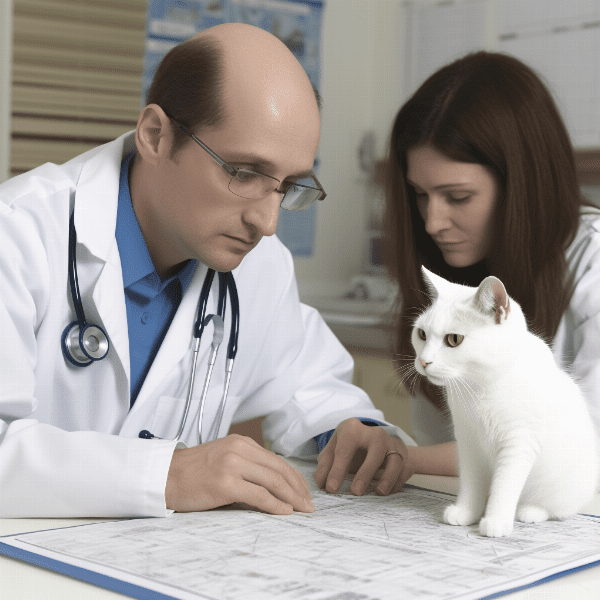
Surgery for Feline Toe Cancer: What to Expect
Anesthesia
Surgery for feline toe cancer typically requires general anesthesia. Your veterinarian will carefully monitor your cat’s vital signs during the surgery to ensure their safety.
The Procedure
During the surgery, your veterinarian will remove the affected toe, including the cancerous cells. In some cases, amputation of the entire limb may be necessary to prevent the spread of cancer. Your veterinarian will use stitches or staples to close the incision site.
Post-Surgery Recovery
After the surgery, your cat will need time to recover. Your veterinarian may prescribe pain medication and antibiotics to prevent infection. You will need to monitor your cat closely and follow your veterinarian’s instructions for caring for the incision site. Your cat may need to wear a cone or other device to prevent them from licking or scratching the incision site.
.
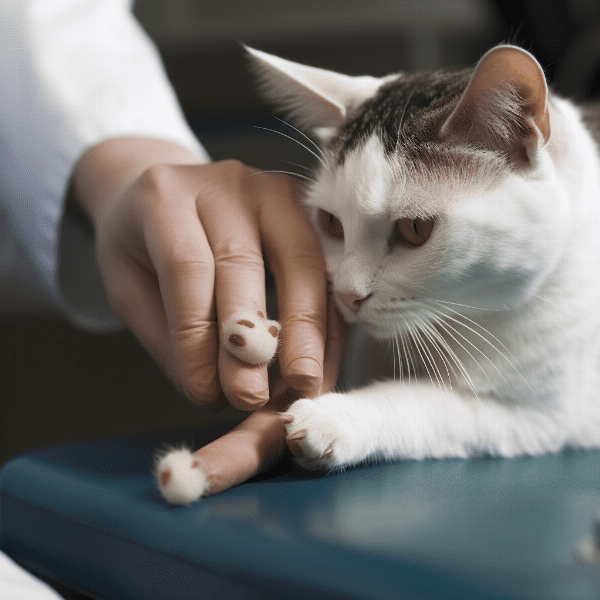
Radiation Therapy for Feline Toe Cancer
.
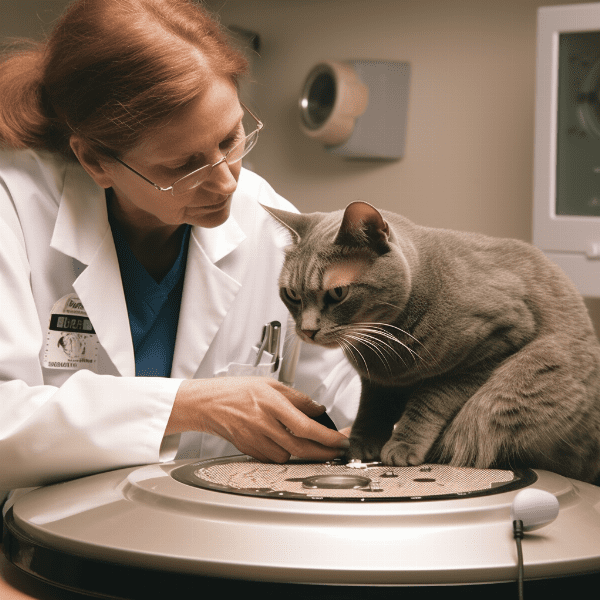
Chemotherapy for Feline Toe Cancer
Chemotherapy is another treatment option for feline toe cancer. It involves using drugs to kill cancer cells and prevent the spread of cancer. Here’s what to expect if your cat undergoes chemotherapy for feline toe cancer:
Pre-Treatment Evaluation
Before chemotherapy, your veterinarian will perform a physical exam and run diagnostic tests to determine the type and stage of the cancer. They will also discuss the procedure with you and answer any questions you may have. Your cat may need to be sedated for the procedure to prevent movement during the treatment.
Treatment Sessions
Chemotherapy may be administered through injections or pills, and the frequency and duration of treatment depend on the type and stage of the cancer. Your cat may receive chemotherapy in multiple sessions over several weeks or months. During the treatment, your cat will need to stay still to ensure the drugs are delivered precisely to the affected area.
Post-Treatment Care
After each chemotherapy session, your cat may experience side effects such as nausea, vomiting, and changes in appetite. Your veterinarian will prescribe medication to manage any pain or discomfort and monitor your cat’s overall health.
.
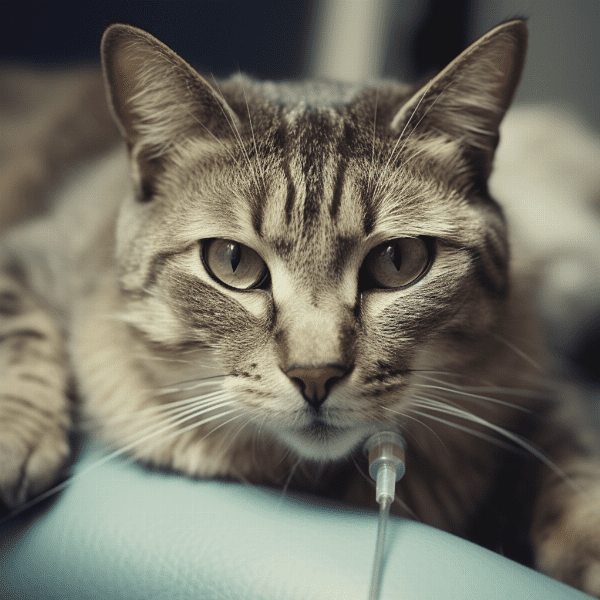
Managing Feline Toe Cancer: Prognosis and Follow-up
After your cat undergoes treatment for feline toe cancer, it’s important to manage the disease and monitor your cat’s health. Here are some factors that may affect your cat’s prognosis and follow-up care:
Prognosis
The prognosis for feline toe cancer depends on several factors, including the type and stage of the cancer, the age and overall health of your cat, and the success of the treatment. In some cases, the cancer may return after treatment, and additional treatments may be necessary.
Follow-Up Care
After treatment, your cat will need to return to the veterinarian for regular follow-up care. Your veterinarian will monitor your cat’s healing and may recommend additional treatments or imaging tests to ensure the cancer has not returned. Your veterinarian may also recommend dietary changes or supplements to support your cat’s overall health.
Quality of Life
Managing feline toe cancer is not just about treating the disease; it’s also about maintaining your cat’s quality of life. Your veterinarian can provide guidance on how to keep your cat comfortable and happy during and after treatment. This may include pain management, dietary changes, or modifications to your cat’s living environment.
Early Detection
Early detection of feline toe cancer can significantly increase the chances of successful treatment and recovery. It’s essential to monitor your cat’s toes regularly for any changes or signs of cancer, such as lumps or bumps, discharge, or changes in behavior.
In summary, managing feline toe cancer requires a combination of follow-up care, early detection, and attention to your cat’s quality of life. Work closely with your veterinarian to monitor your cat’s health and manage the disease effectively. With proper care and treatment, many cats with feline toe cancer can live happy, healthy lives.

Preventing Feline Toe Cancer: Tips for Cat Owners
While feline toe cancer can occur in any cat, there are steps you can take to reduce your cat’s risk of developing this disease. Here are some tips for preventing feline toe cancer:
Sun Protection
Exposure to sunlight is a known risk factor for feline toe cancer. Limit your cat’s exposure to sunlight, especially during peak hours, and provide shade in outdoor areas.
Toe Care
Regularly inspect your cat’s toes for any signs of lumps, bumps, or other abnormalities. Keep your cat’s toes clean and trimmed to reduce the risk of injury or infection.
Healthy Diet
A healthy diet can help support your cat’s overall health and reduce the risk of cancer. Feed your cat a balanced diet with high-quality ingredients and avoid processed foods.
Indoor Environment
Indoor cats have a lower risk of developing feline toe cancer than outdoor cats. Consider keeping your cat indoors or providing a safe, enclosed outdoor area.
Regular Veterinary Care
Regular veterinary care can help detect feline toe cancer early and improve the chances of successful treatment. Take your cat to the veterinarian for regular check-ups and promptly report any changes in behavior or health.
In summary, taking steps to prevent feline toe cancer can help reduce your cat’s risk of developing this disease. Sun protection, toe care, a healthy diet, an indoor environment, and regular veterinary care are all essential components of feline cancer prevention. Work closely with your veterinarian to keep your cat healthy and happy.
